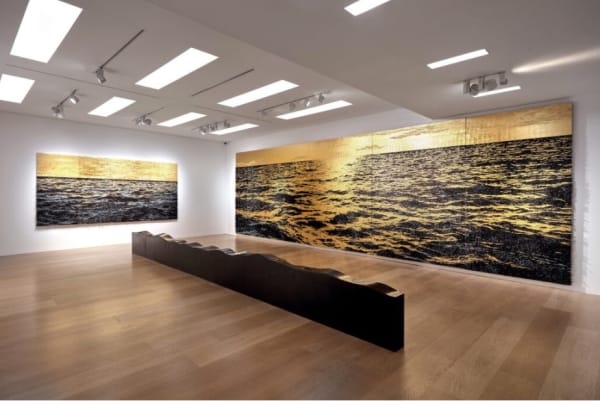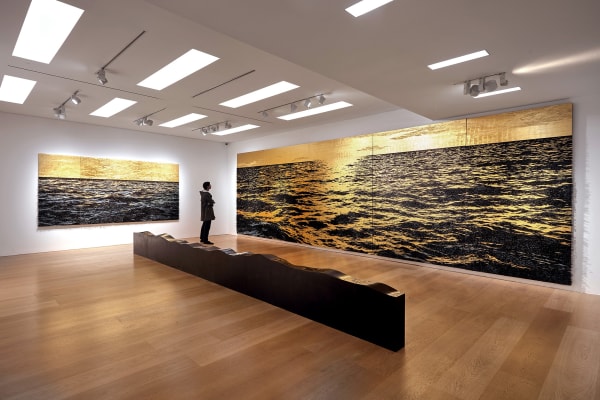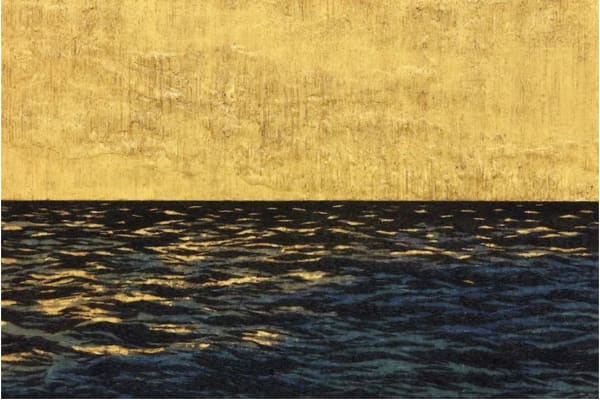Yoan Capote - Requiem
Ben Brown Fine Arts is pleased to announce Requiem, an exhibition of new works by Cuban artist Yoan Capote. This is the artist's fourth solo exhibition with Ben Brown Fine Arts, and third solo exhibition at the London gallery. Opening in September 2021, the exhibition presents a new progression in the artist's practice with the introduction of gold leaf into his iconic seascape paintings. The dazzling gold leaf, monumental scale, and meticulous incorporation of fishhooks in these paintings evoke a spiritual quality, inviting reflection and refuge in a time of great upheaval.
The gallery space will be transformed by the installation of these vast canvases - among the largest works ever created by the artist - immersing the viewer from the perspective of being surrounded by sea, on an island similar to Capote's Cuba. The tantalizing horizon line conjures feelings of promise, hope, uncertainty, loneliness and even fear. The seascape paintings, now imbued with a precious material that evokes classical artistic traditions of centuries past, are a metaphor for the migrant crises around the world and the need for spiritual healing and respite as we experience global health, political and environmental catastrophes.
-

THE TOP 5 EXHIBITIONS TO SEE IN LONDON AFTER FRIEZE WEEK
Tabish Khan for FAD Magazine 2021年10月18日Tabish Khan picks his top exhibitions to see right now, the art fairs have left town but there&rsquo...更多 -

Yoan Capote ‘When a Cuban looks at the sea, he remembers the isolation and pain of thousands of families’
Yoan Capote interviewed by Anna Mcnay for Studio International Magazine 2021年9月23日The artist talks about his new series of large-scale paintings, Requiem, and how his work is influen...更多
Ben Brown Fine Arts is pleased to announce Requiem, an exhibition of new works by Cuban artist Yoan Capote. This is the artist's fourth solo exhibition with Ben Brown Fine Arts, and third solo exhibition at the London gallery. Opening in September 2021, the exhibition presents a new progression in the artist's practice with the introduction of gold leaf into his iconic seascape paintings. The dazzling gold leaf, monumental scale, and meticulous incorporation of fishhooks in these paintings evoke a spiritual quality, inviting reflection and refuge in a time of great upheaval.
The gallery space will be transformed by the installation of these vast canvases - among the largest works ever created by the artist - immersing the viewer from the perspective of being surrounded by sea, on an island similar to Capote's Cuba. The tantalizing horizon line conjures feelings of promise, hope, uncertainty, loneliness and even fear. The seascape paintings, now imbued with a precious material that evokes classical artistic traditions of centuries past, are a metaphor for the migrant crises around the world and the need for spiritual healing and respite as we experience global health, political and environmental catastrophes.
The sea is a longstanding theme in Capote's work, reflecting his experiences of growing up on the politically isolated island of Cuba and the yearning for the world beyond, and more generally as a symbol of allure and danger, freedom and isolation, hope and tragedy. These dualities are revealed in the Requiem paintings - they are at once transcendental meditations on the sublime beauty and boundlessness of the wild seas, bathed in a divine golden light, yet their construction of sharp, menacing fishhooks, many tainted with traces of blood, firmly connotes the dangers and impossibility of migration experienced by many Cubans, and countless others around the world.
Throughout art history gold leaf has signified purity, divinity and the unearthly, as in the early Renaissance paintings that inspired Capote during his travels in Florence, Italy. The paintings in the Requiem series are similarly imbued with a sense of the sacred, rousing contemplation and inspiring awe. In juxtaposing these divergent materials, Capote was able to explore the fragility of the 'golden dream' that draws many toward a horizon often fraught with unseen danger. Although traditionally applied to a flat surface, in these works the gold leaf is transferred onto thick layers of impasto, emphasising the tactility of the paint surface, and creating a resplendent play of light on the shifting seas. A classically trained artist with a reverence for Edo period Japanese print-making and 19th century Romantic landscape painting, as well as the early-Renaissance, Capote sees these works as a way to reconnect with traditional artistic techniques, revealing the universality and spiritual value of painting.













